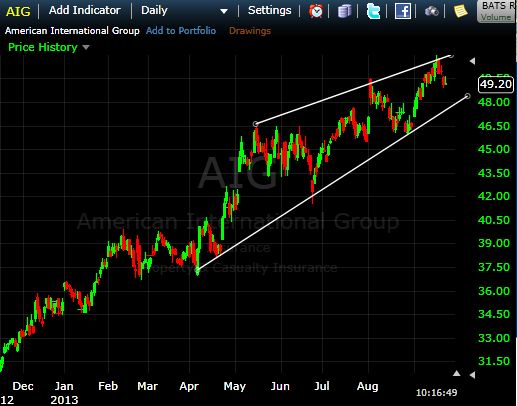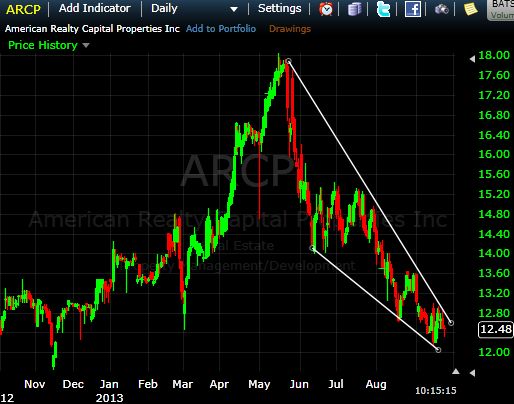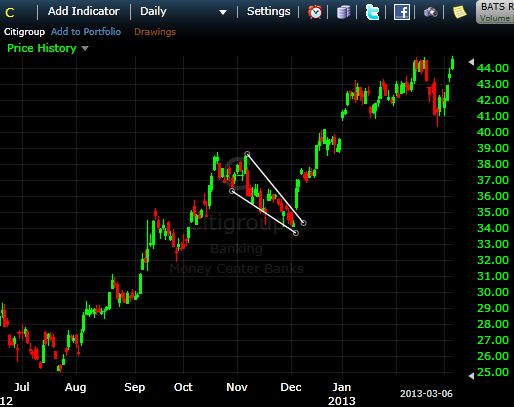The Wedge Reversal Pattern
The wedge is fairly common pattern, and if you familiar with Elliott Wave analysis a wedge often appears in wave 5–the final stage–of a trend. Rising wedges are bearish and falling wedges are bullish. Depending on trend direction and the angle of the wedge, that could mean there are occasions when a wedge is a continuation pattern. Here we’ll learn how to identify a wedge as either a reversal or continuation pattern, or then how to trade it. Wedges can be very large, creating major moves in markets and are therefore very relevant to traders on all time frames.
Wedge Structure
A wedge occurs when the price is moving either higher or lower overall, but the price range covered is narrowing. The pattern starts with a large move, but as the pattern progress the swing highs and lows in price converge, creating a cone like shape. In a rising wedge, this pattern indicates buyers are as interested as they once were. A falling wedge shows sellers are no longer as interested as they once were.
Figure 1 shows a rising wedge in American International Group (AIG) and figure 2 a falling wedge in American Realty Capital Properties (ARCP).
Figure 1. Rising Wedge in AIG

Figure 2. Falling Wedge in ARCP

Reversal Wedges
Price will typically breakout of a wedge in the opposite direction the wedge is sloping. Figure 1 and 2 are considered reversal patterns because the wedge is part of the overall trend and therefore when the pattern breaks it will signal a likely end to the current trend.
In the case of figure 1, AIG is in overall uptrend, but if the price breaks below the support line of the pattern (horizontal line connecting the price lows of the pattern) it is a strong indication that the uptrend is over and the price is likely to fall.
In the case of figure 2 the right side of the charts shows the price in a downtrend, but if the price breaks above resistance (horizontal line connecting the price highs of the pattern) it strongly indicates the downtrend is over and the price is likely to head higher.
Therefore reversal wedges are part of the overall trend, and indicate that trend is ending when the pattern breaks out in the opposite direction of the wedge/trend.
Wedges often see a “throw-over” in the direction of the trend/wedge. For example, in figure 1 you may the price rise above the resistance line which some will interpret as an acceleration of the trend to the upside. Don’t trust a throw-over though; quite often these types of price moves quickly fail and then the price falls through the bottom of the wedge.
Therefore, I prefer to wait and only trade wedges in the direction I expect the breakout to occur. In a downtrend or falling wedge, wait for the price to break resistance and then go long. In an uptrend or rising wedge wait for the price to break through support and then go short.
Continuation Wedges
For a wedge to be a reversal pattern we saw that the wedge is part of the trend and moving in the same direction as the overall trend. It is possible to have smaller wedges though. Assume for a moment the a market is in an overall downtrend, then price then begins to move higher in a wedge formation, but compared to the overall downtrend this wedge is quite small. In this case the wedge signals that the trend direction is likely to continue once the price breaks below the wedge pattern.
Figure 3 shows an overall uptrend in Citigroup (C), but a small wedge forms moving in the opposite direction of the trend. In this case the wedge is likely to be a continuation pattern (meaning the trend is likely to continue). For one, we have a strong trend up and the wedge does not form the trend but is rather just a consolidation showing the stock is pausing. Also, the price will typically breakout out in the opposite direction the wedge is sloping–which in this case is higher, and in alignment with the trend.
Figure 3. Continuation Wedge in C

Final Word
Whether you see a wedge which is the trend, or a small wedge which is a consolidation within an overall trend, the pattern is quite tradable. We know that wedges generally breakout in the opposite direction they are sloping. While there may be exceptions to this, typically I will only take trades where this condition is met. When a large uptrend or downtrend takes a on a wedge formation, it typically signals a major reversal could be forthcoming when the price breaks to the downside or upside, respectively. Since we draw lines on the chart to mark the pattern which can be somewhat subjective, it is possible to get the occasional false breakout. Therefore, I won’t usually take a trade the second the price breaks the support/resistance I have drawn, but rather wait to see if the price continues to move outside the pattern–if it does, then I will take the trade.